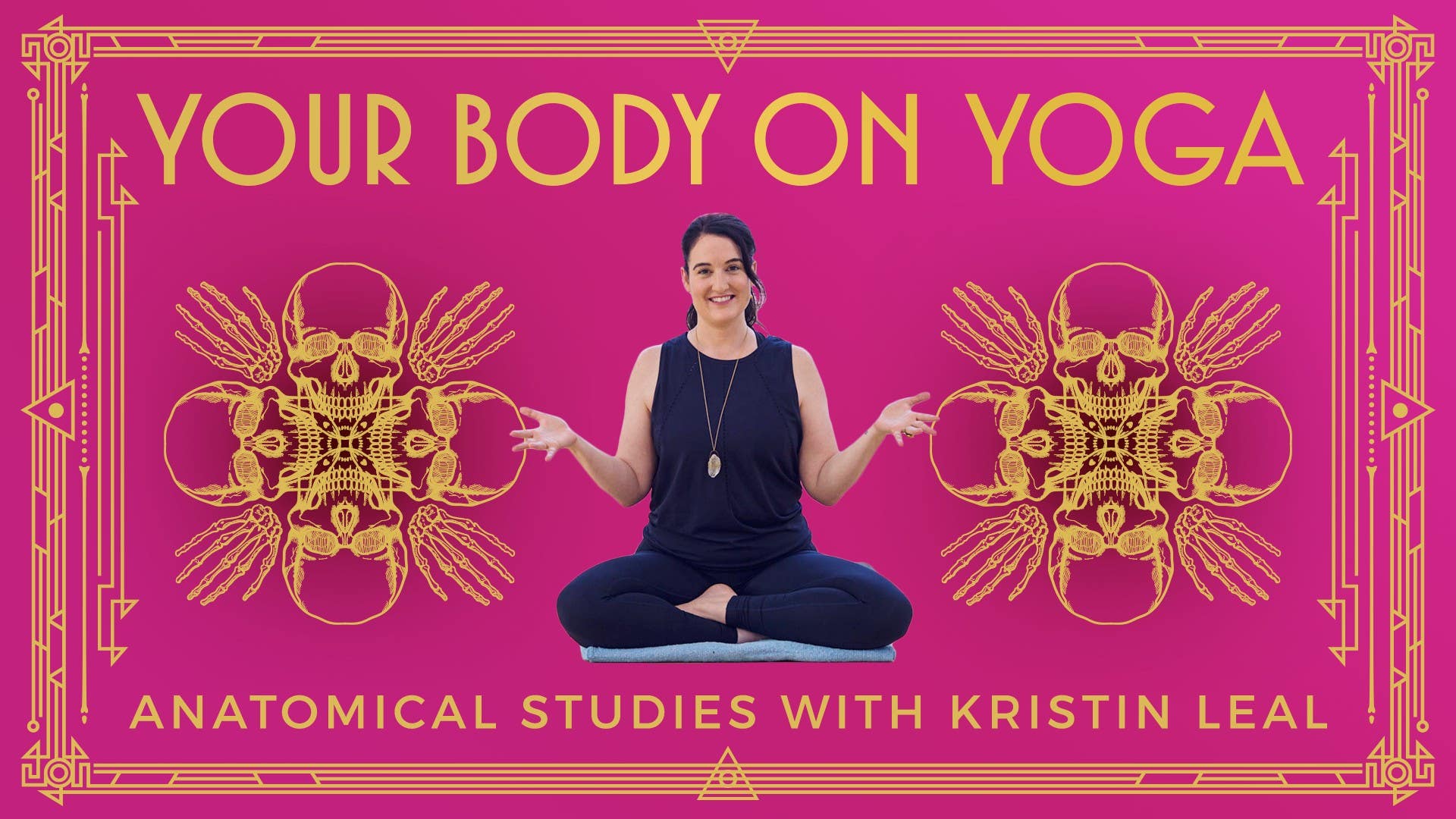Description
Please see attached .pdf below on Breathing Muscles of the Torso to assist with this class.
About This Video
Transcript
Read Full Transcript
Let's welcome Jean-Luc, so named after my very first crush, who was a very short and muscular fella in the ballet company I used to work for. So as we look at the muscles of the body, I like to look at the torso. So if we look at the back of Jean-Luc, we can see that it's mostly covered by the superficial muscles of the trapezius and the latissimus dorsi. The trapezius is this kind of diamond-shaped muscle that has attachment to the base of the skull, sweeps across the shoulders, it's removed on the side so you can see underneath, but sweeps across almost like a hanger, like a sweater on a hanger, and then dives down to a point to the last thoracic vertebrae, forming those downward fibers. The latissimus dorsi rises from the back body, almost like bat wings, and attaches to the humerus.
Now, if we were to take off those superficial back muscles, we're going to see some muscles I like to spend a little bit more time with, and those are our erector spinae muscles. Now it's not just one muscle, but it's actually a group of three moving medial to lateral, and three moving from superficial to deep. Now as a team, they do what they sound like, they erect the spine, they hold it upright. If you contract and shorten them, they bring you into extension. Now here's an example of one muscle or muscle group that because it's so vast, or it covers so much territory in the back, that it's possible to have one area that's hypercontracted, one area that's weak, one area that's kind of a mixed bag of the two.
Each side could appear differently because of our habitual asymmetries. And so this is another reason why muscles are not as simple as maybe they first appear. The erector spinae muscles in the upper back tend to be pretty weak, which brings us into that poor posture that we all tend to default in, with the pelvis tucked under, the heart kind of sunken, and then the erector spinae in the neck tend to be hypercontracted as we take that kind of head forward position. The quadratus lumborum sounds maybe a little bit scary when you first hear the names of these muscles, but they're always named for something. The quad, meaning four, it's a four-sided kind of rectangular muscle that hangs out in the lumborum, the lower back region.
So as attachment to the last rib, the twelfth rib on either side, dives down to the iliac crest and then up the transverse processes of the lumbar region. If you take your hands to your waist, almost like you're a caricature of someone who's mad, and you poke your thumbs in, and then you do a little side bending, a little lateral flexion, or a little hip hike. You'll feel that muscle perhaps contract under your fingers and shorten. This is a big muscle of trouble or tension that most students will show up into the room with. So a lot of times we're working to release some muscular tension in the quadratus lumborum while strengthening the muscles of the erector spinae.
So in the practice that we'll follow, we're going to work on strengthening and releasing this area. If we were to spin around to the front of Jean-Luc, we'll see his abdominal set. Now the abs are something that we've all heard of and we've all worked on, or maybe we're working to kind of strengthen our abs, do ab work. The abs are four, actually four different muscles moving from superficial to deep. Starting with the most superficial, we see the rectus abdominis.
If you take your own hands to the front line of your belly, from your xiphoid process down to the pubic bone, you might feel that there's a little band, a little separation between the two kind of bellies or two halves of the rectus abdominis. This band is almost like, if you have one of those tufted couches with the buttons that are pulled down, they're pulled down so taut that the puffy cushions kind of poke up right around it. This band is pulled pretty taut. It's called the linea alba, not Jessica alba, but the linea alba, and that is pulled taut, making the bellies of the rectus abdominis muscles kind of poke out. You also have lesser known kind of transverse lines or horizontal lines that also provide this look of having four bellies on either side, or your six-pack, it actually could be an eight-pack, but those lower abs are not so developed.
I would show you mine, but I'm very shy. If we were to take the rectus abdominis off, we would see, deeper still, there would be the external and internal obliques, and these form what's called a chevron pattern, kind of like one was a V pointing down, and one is a V pointing up, like a mountain point. These kind of external and internal obliques are actually continuous with the intercostal muscles, the external and internal intercostals, and these are the muscles that are in between each rib. Now, because they're in different regions, and we could separate with a line or a scalpel, they have some different jobs to do. We call them as two distinct muscles, external, on the outside, internal, on the inside, but when you really look at it on a real body, it's one hunk of muscle, and they're continuous with the obliques.
The rectus abdominis claim to fame, not just the bodybuilder six-pack or eight-pack, but also bringing the lumbar spine into flexion, like you were to do like a Jane Fonda crunch. The external and internal obliques also do that action, but then for added bonus, they do some rotation and also some lateral flexion. The deepest still, if we were to take those external and internal obliques off and we peered underneath, we would see the transversus abdominis, so it's the innermost girdle around the lower back. It actually starts posterior in the lower back space and wraps around, and this one is hard to feel or identify because it's so, so darn deep, but if you were to place your hands on your belly and you were to like belly laugh, you might feel this kind of jolly squish of your transversus abdominis, or if you were to cough, you might feel it, or don't do this now, but bowel movement, not now, later, think of me, the innermost layer of the transversus abdominis might contract for that action to occur. The transversus abdominis also does this act of flexion, but really its claim to fame is supporting the inner girdle around that lumbar spine.
Two more muscles. We have in our neck region what's called the sternocleidomastoid, fancy name, I know it sounds a little weird, sometimes we shorten it by just saying the SCM when you're cool, but the sternum, we've heard that word, the sternum, clido comes from the same root as clavicle, and mastoid is this little process right behind the soft squishy part of your ear, right behind your earlobe, there's a little point, and so that sternocleidomastoid is that muscle, kind of strap muscle that you can see and feel in your neck in these two. Now, these muscles in unison will bring the head down into flexion, or if your head is stable they'll let the sternum and collarbones rise, inspire, inflate. And then the scalenes are deep neck muscles that also attach to the first couple ribs on either side, they're helpful in rotation, but also in inspiration in that movement of the first two ribs upward to take in that really big breath. All of these muscles that we talked about are extremely important in breathing, and especially in these deeper breaths that we're asking for in a yoga practice.
So as you breathe right here and now, not really giving it much thought, there's very little movement that you can perceive or feel or see from the outside, but as you're expanding the breath, exaggerating the breath, more of the accessory muscles of breathing need to take part in this dance that we're doing. So as you begin to take that slow, really big inhale, the erector spinae set will begin to contract and shorten, bringing you into the tiniest little cow pose, bringing more room, more influence for this breath to fill you. The quadratus lumborum on both sides will pull the 12th rib down towards the pelvic bowl to give even more space in the rib cage for that breath to fill. Your abdominal set might even begin to relax, so as the diaphragm is descending, it can kind of squish the organs out and they'll have a little bit of give, the belly kind of receives the breath. Then to get even the top parts of the breath, now you're still inhaling your collarbones, your sternum and the first couple ribs on either side have to get out of the way, so the SCM and the scalenes will shorten to bring the biggest breath in.
Now as you exhale, the sternocleidomastoid and scalenes can relax, the belly can engage, erector spinae and quadratus lumborum can soften, and you move into a teeny tiny cow pose. And that's why when your teacher is sequencing or you're sequencing a practice, things that look like this work better with an inhale, things that look like this work better with an exhale, because it follows this kind of natural play of the movement of the accessory muscles with your breath. Now if we're holding that kind of text neck, that poor posture that many of us come into the practice with, you're losing the availability of this top third of the breath. The SCM and scalenes kind of stuck and won't make this area available to breathe. Same thing if you throw your head back on the top of the inhale, and that's in the backbending moves like inhale, urdvahastasana, inhale, upper dog, a lot of us want to throw the head back to feel that backbend, we're kind of putting offline access to this, the juiciest part of the breath, the top third of the breath.
So keeping this in mind, letting all of the muscles of the torso coordinate in this dance to help you receive the breath, support and inspiration.
Your Body on Yoga: Torso
Comments
You need to be a subscriber to post a comment.
Please Log In or Create an Account to start your free trial.










